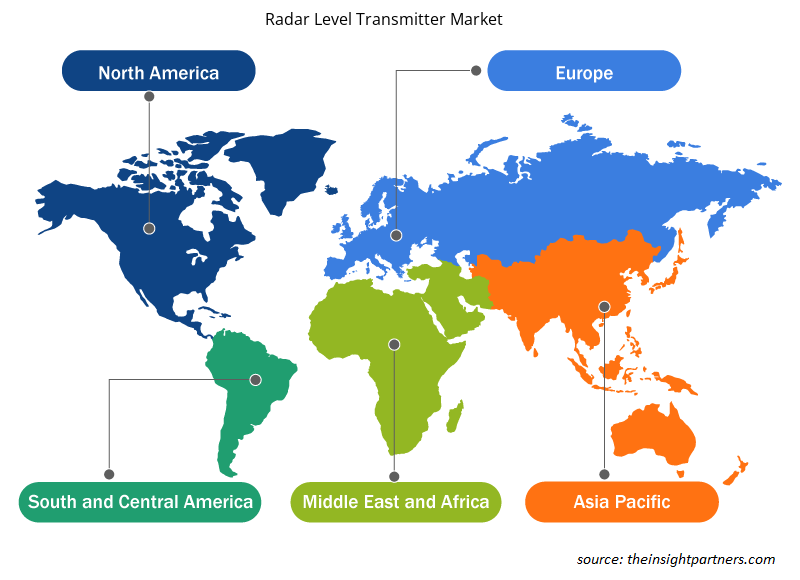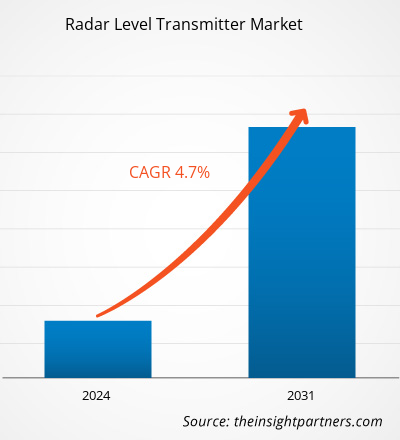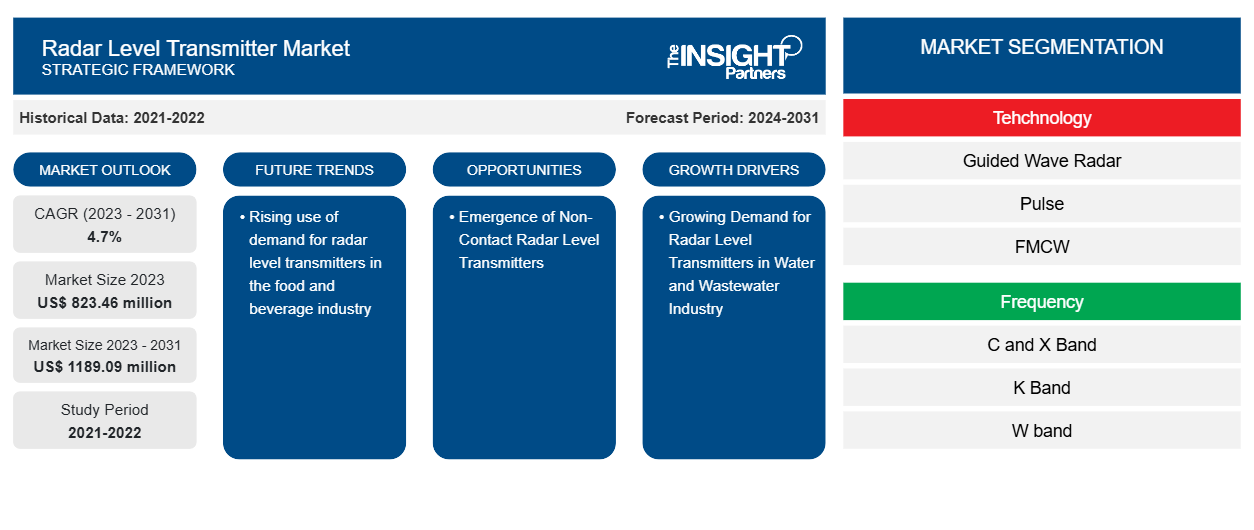Der Markt für Radar-Füllstandmessgeräte soll von 823,46 Millionen US-Dollar im Jahr 2023 auf 1.189,09 Millionen US-Dollar im Jahr 2031 anwachsen. Der Markt soll zwischen 2023 und 2031 eine durchschnittliche jährliche Wachstumsrate (CAGR) von 4,7 % verzeichnen. Die steigende Nachfrage nach Radar-Füllstandmessgeräten in der Lebensmittel- und Getränkeindustrie dürfte ein wichtiger Markttrend bleiben.
Radar-Füllstandtransmitter Marktanalyse
Der Markt für Radar-Füllstandtransmitter wächst aufgrund der Vorteile der hohen Stabilität, Zuverlässigkeit und Präzision, die diese Transmitter bieten. Darüber hinaus fördert die zunehmende Betonung von Anlagenoptimierung und -effektivität das Wachstum des Marktes auf globaler Ebene. Darüber hinaus besteht eine wachsende Nachfrage nach drahtlosen Radar-Füllstandtransmittern, insbesondere für Anwendungen in abgelegenen Gebieten in den Bereichen Bergbau, Öl und Gas sowie Chemie und Petrochemie, was das Wachstum des Marktes für Radar- Füllstandtransmitter weiter vorantreibt . Darüber hinaus schaffen zunehmende industrielle und wirtschaftliche Verbesserungen in Schwellenländern neue Möglichkeiten für Marktteilnehmer, ihren Kunden fortschrittlichere Lösungen anzubieten, was das Wachstum des Marktes für Radar-Füllstandtransmitter weiter fördert.
Marktübersicht zu Radar-Füllstandtransmittern
Radar-Füllstandstransmitter sind elektronische Geräte zur Messung von Flüssigkeitsständen. Diese Füllstandstransmitter helfen dabei, Flüssigkeitsstände mithilfe von Radartechnologie zu erkennen. Zahlreiche Branchen, darunter Lebensmittel und Getränke, Fertigung, Bauwesen, Öl und Gas sowie Industrie, nutzen die Technologie der Radar-Füllstandstransmitter in großem Umfang. Diese Technologie basiert auf der Berechnung der Zeit, die für eine Fahrt zwischen dem Wandler und dem gemessenen Materialstand erforderlich ist. Radar-Füllstandstransmitter eignen sich am besten für raue Umgebungen, in denen Nebel, Staub oder eine schaumige Oberfläche den Einsatz eines Ultraschalltransmitters verhindern.
Passen Sie diesen Bericht Ihren Anforderungen an
Sie erhalten kostenlos individuelle Anpassungen an jedem Bericht, einschließlich Teilen dieses Berichts oder einer Analyse auf Länderebene, eines Excel-Datenpakets sowie tolle Angebote und Rabatte für Start-ups und Universitäten.
- Holen Sie sich die wichtigsten Markttrends aus diesem Bericht.Dieses KOSTENLOSE Beispiel umfasst eine Datenanalyse von Markttrends bis hin zu Schätzungen und Prognosen.
Markttreiber und Chancen für Radar-Füllstandtransmitter
Steigende Nachfrage nach Radar-Füllstandmessgeräten in der Wasser- und Abwasserindustrie
Der Wasserversorgungssektor wird dazu gedrängt, Wasseraufbereitungstechniken zu verbessern, da die Anforderungen an eine gleichbleibende Wasserqualität steigen und die Kontrolle der Wasserqualität strenger und strenger wird. Die Technologie der Radar-Füllstandtransmitter ist eine sehr wirtschaftliche Alternative für Wasserprojekte und kann Füllstände unter rauen Bedingungen messen. Während des Abwasseraufbereitungsprozesses ist die Auswahl des geeigneten Abwasser-Füllstandtransmitters von entscheidender Bedeutung. Radar-Füllstandtransmitter werden verwendet, um Abwasserstände in jeder Phase des Abwassernetzes und der Aufbereitungstechnik zu überwachen und liefern wichtige Kontroll- und Prozesseingaben, die das Wachstum des Marktes für Radar-Füllstandtransmitter weltweit vorantreiben.
Einführung berührungsloser Radar-Füllstandmessgeräte
Berührungslose Verfahren eignen sich besser für unsaubere, viskose und korrosive Anwendungen sowie bei der Verwendung von Rührwerken. Berührungslose Radarsender verwenden die frequenzmodulierte Dauerstrichtechnologie (FMCW) zur Messung von Füllständen. Darüber hinaus werden diese Sender zur Verbesserung der Messgenauigkeit und -zuverlässigkeit eingesetzt und können für ein breiteres Anwendungsspektrum verwendet werden. Darüber hinaus bleibt die Genauigkeit durch Schwankungen der Mediendichte, Temperatur, Staub und des Drucks unbeeinflusst, was voraussichtlich weitere Wachstumschancen für den Markt für Radar-Füllstandsender schaffen wird.
Radar-Füllstandtransmitter-Marktbericht – Segmentierungsanalyse
Wichtige Segmente, die zur Ableitung der Marktanalyse für Radar-Füllstandstransmitter beigetragen haben, sind Technologie, Frequenz, Medium und Branche.
- Basierend auf der Technologie ist der Markt für Radar-Füllstandtransmitter in geführte Wellenradare, Impulsradare und FMCW unterteilt. Das Segment der geführten Wellenradare hatte im Jahr 2023 einen größeren Marktanteil.
- Nach Frequenz ist der Markt in C&X-Band, K-Band und W-Band segmentiert. Das C&X-Bandsegment hatte im Jahr 2023 den größten Marktanteil.
- Nach Medien ist der Markt in fest und flüssig segmentiert. Das feste Segment hatte im Jahr 2023 den größten Marktanteil.
- Nach Branchen ist der Markt in Öl und Gas, Chemikalien, Lebensmittel und Getränke und andere unterteilt. Das Öl- und Gassegment hatte im Jahr 2023 den größten Marktanteil.
Radar-Füllstandtransmitter Marktanteilsanalyse nach Geografie
Der geografische Umfang des Marktberichts für Radar-Füllstandstransmitter ist hauptsächlich in fünf Regionen unterteilt: Nordamerika, Asien-Pazifik, Europa, Naher Osten und Afrika sowie Südamerika/Süd- und Mittelamerika.
Der Nahe Osten und Afrika erlebt ein enormes Wachstum bei Radar-Füllstandtransmittern aufgrund ihrer enormen Verwendung in den Bereichen Öl, Gas und Chemie. Da die Region einer der größten Öl- und Gasproduzenten ist, steigt die Nachfrage nach diesem Transmitter. Laut der International Trade Administration gehören die Vereinigten Arabischen Emirate zu den zehn größten Ölproduzenten der Welt. Etwa 96 % der Ölreserven des Landes, rund 100 Milliarden Barrel, befinden sich in Abu Dhabi. Ebenso verfügt Saudi-Arabien über etwa 17 % der nachgewiesenen Erdölreserven der Welt , was das Land zu einem der größten Erdölexporteure macht. Außerdem verfügt das Land über die zweitgrößten nachgewiesenen Ölreserven der Welt. Darüber hinaus ergreifen die Regierungen der oben genannten Länder verschiedene Initiativen, um die Öl- und Erdölproduktion zu steigern, was das Wachstum des Marktes für Radar-Füllstandtransmitter weiter vorantreibt.
Regionale Einblicke in den Markt für Radar-Füllstandtransmitter
Die regionalen Trends und Faktoren, die den Markt für Radar-Füllstandtransmitter im gesamten Prognosezeitraum beeinflussen, wurden von den Analysten von Insight Partners ausführlich erläutert. In diesem Abschnitt werden auch die Marktsegmente und die Geografie von Radar-Füllstandtransmittern in Nordamerika, Europa, im asiatisch-pazifischen Raum, im Nahen Osten und Afrika sowie in Süd- und Mittelamerika erörtert.

- Erhalten Sie regionalspezifische Daten zum Markt für Radar-Füllstandmessumformer
Umfang des Marktberichts über Radar-Füllstandtransmitter
| Berichtsattribut | Details |
|---|---|
| Marktgröße im Jahr 2023 | 823,46 Millionen US-Dollar |
| Marktgröße bis 2031 | 1189,09 Millionen US-Dollar |
| Globale CAGR (2023 - 2031) | 4,7 % |
| Historische Daten | 2021-2022 |
| Prognosezeitraum | 2024–2031 |
| Abgedeckte Segmente | Von Technology
|
| Abgedeckte Regionen und Länder | Nordamerika
|
| Marktführer und wichtige Unternehmensprofile |
|
Marktteilnehmerdichte für Radar-Füllstandtransmitter: Auswirkungen auf die Geschäftsdynamik verstehen
Der Markt für Radar-Füllstandtransmitter wächst rasant, angetrieben durch die steigende Nachfrage der Endnutzer aufgrund von Faktoren wie sich entwickelnden Verbraucherpräferenzen, technologischen Fortschritten und einem größeren Bewusstsein für die Vorteile des Produkts. Mit steigender Nachfrage erweitern Unternehmen ihr Angebot, entwickeln Innovationen, um die Bedürfnisse der Verbraucher zu erfüllen, und nutzen neue Trends, was das Marktwachstum weiter ankurbelt.
Die Marktteilnehmerdichte bezieht sich auf die Verteilung von Firmen oder Unternehmen, die in einem bestimmten Markt oder einer bestimmten Branche tätig sind. Sie gibt an, wie viele Wettbewerber (Marktteilnehmer) in einem bestimmten Marktraum im Verhältnis zu seiner Größe oder seinem gesamten Marktwert präsent sind.
Die wichtigsten auf dem Markt für Radar-Füllstandstransmitter tätigen Unternehmen sind:
- AMETEK
- ABB
- Emerson Electric Co.
- Honeywell International Inc.
- KROHNE
- Schneider Electric
Haftungsausschluss : Die oben aufgeführten Unternehmen sind nicht in einer bestimmten Reihenfolge aufgeführt.

- Überblick über die wichtigsten Akteure auf dem Radar-Füllstandmessumformer-Markt
Marktnachrichten und aktuelle Entwicklungen zum Radar-Füllstandtransmitter
Der Markt für Radar-Füllstandtransmitter wird durch die Erfassung qualitativer und quantitativer Daten nach Primär- und Sekundärforschung bewertet, die wichtige Unternehmensveröffentlichungen, Verbandsdaten und Datenbanken umfasst. Im Folgenden finden Sie eine Liste der Entwicklungen auf dem Markt für Sprach- und Sprechstörungen und Strategien:
- KROHNE, Inc. gab die Erweiterung seiner Produktlinie um drei 24 GHz und drei 80 GHz OPTIWAVE Radar-Füllstandtransmitter bekannt, die die bestehenden 10 GHz-Geräte ergänzen. Die gesamte Palette der OPTIWAVE 2-Leiter-FMCW-Radar-Füllstandtransmitter mit Schleifenspeisung für Flüssigkeiten und Feststoffe eignet sich ideal für Branchen von der Chemie und Petrochemie bis hin zum Bergbau, der Mineralien- und Metallverarbeitung und deckt sowohl Flüssigkeits- als auch Feststoffanwendungen ab. (Pressemitteilung, 2022)
- Emerson gab die Entwicklung des Füllstandstransmitters Rosemount 1408H bekannt, dem weltweit ersten berührungslosen Radargerät, das speziell für die Lebensmittel- und Getränkeindustrie entwickelt wurde. Zu den speziellen Funktionen gehören ein hygienisches, kompaktes Design, eine schnelle Sweep-Technologie, eine außergewöhnliche Fokussierung des Radarstrahls und IO-Link-Kommunikation, die Herstellern helfen, die Effizienz ihrer Abläufe zu optimieren, Produktverluste zu reduzieren und die Lebensmittelsicherheit zu gewährleisten. (Quelle: Emerson, Pressemitteilung, 2021)
Marktbericht zu Radar-Füllstandtransmittern – Abdeckung und Ergebnisse
Der Bericht „Marktgröße und Prognose für Radar-Füllstandstransmitter (2021–2031)“ bietet eine detaillierte Analyse des Marktes, die die folgenden Bereiche abdeckt:
- Marktgröße und Prognose auf globaler, regionaler und Länderebene für alle wichtigen Marktsegmente, die im Rahmen des Projekts abgedeckt sind
- Marktdynamik wie Treiber, Beschränkungen und wichtige Chancen
- Wichtige Zukunftstrends
- Detaillierte PEST/Porters Five Forces- und SWOT-Analyse
- Globale und regionale Marktanalyse mit wichtigen Markttrends, wichtigen Akteuren, Vorschriften und aktuellen Marktentwicklungen
- Branchenlandschaft und Wettbewerbsanalyse, einschließlich Marktkonzentration, Heatmap-Analyse, prominenten Akteuren und aktuellen Entwicklungen
- Detaillierte Firmenprofile
- Historische Analyse (2 Jahre), Basisjahr, Prognose (7 Jahre) mit CAGR
- PEST- und SWOT-Analyse
- Marktgröße Wert/Volumen – Global, Regional, Land
- Branchen- und Wettbewerbslandschaft
- Excel-Datensatz
Aktuelle Berichte
Verwandte Berichte
Erfahrungsberichte
Grund zum Kauf
- Fundierte Entscheidungsfindung
- Marktdynamik verstehen
- Wettbewerbsanalyse
- Kundeneinblicke
- Marktprognosen
- Risikominimierung
- Strategische Planung
- Investitionsbegründung
- Identifizierung neuer Märkte
- Verbesserung von Marketingstrategien
- Steigerung der Betriebseffizienz
- Anpassung an regulatorische Trends





















 Kostenlose Probe anfordern für - Markt für Radar-Füllstandsmessumformer
Kostenlose Probe anfordern für - Markt für Radar-Füllstandsmessumformer